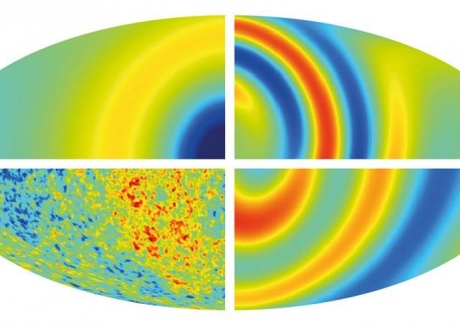
The idea that it is uniform does not appear to be correct when you consider just how clumpy it appears to be, for example planets orbiting stars and then lots of empty space between stars. Scale up, and you have stars bunched up into galaxies and lots of space between galaxies, but keep scaling up and you reach a point at which the distribution of matter is more or less uniform. This is known as the cosmological principle.
How can you make such a principle?
OK, so think of it this way, since the forces are expected to act uniformly throughout the universe, then we should not find irregularities. Well yes, obviously Earth is not the same as the Sun and obviously the Sun is not the same as a black hole, so clearly at that scale it is not uniform. The universe itself is more akin to foam with clusters of galaxies and voids, but none of that defies basic physics and so the observation is that it is all more or less the same in every direction and there are no weird bumps in the large scale distribution of matter.
Is this testable?
Well basically yes.
If true then no matter where you are in the universe it should look the same and obviously no matter what direction you look, it should look the same.
Is this a new Idea?
Nope, Newton first wrote this down within The Principia (or to give it it’s full name, Philosophiæ Naturalis Principia Mathematica (1687)) when he articulated the idea that gravitation was universal and applied to all the planets and stars …
“the light of the fixed stars is of the same nature with the light of the Sun, … and lest the systems of the fixed stars should, by their gravity, fall on each other, [God] hath placed those systems at immense distances from one another”
OK, so why are you writing about it now?
The basic idea has been coming under stress, for example observations of large scale structures in the universe, so asking if it is really true is wholly appropriate.
The latest news is that scientists from University College London and Imperial College London tested the basic idea by examining the cosmic microwave background (CMB) maps to see if they could find any patterns that conflicted with the idea that the universe was indeed Uniform. The Imperial college article on the study explains …
The maps were produced using measurements of the CMB taken between 2009 and 2013 by the European Space Agency’s Planck satellite, providing a picture of the intensity and, for the first time, polarisation (in essence, the orientation) of the CMB across the whole sky.
Previously, scientists had looked for patterns in the CMB map that might hint at a rotating universe. The new study considered the widest possible range of universes with preferred directions or spins and determined what patterns these would create in the CMB.
A universe spinning about an axis, for example, would create spiral patterns, whereas a universe expanding at different speeds along different axes would create elongated hot and cold spots
Dr Stephen Feeney, from the Department of Physics at Imperial, worked with a team led by Daniela Saadeh at University College London to search for these patterns in the observed CMB. The results, published today in the journal Physical Review Letters, show that none were a match, and that the universe is most likely directionless.
If they had discovered that the cosmological principle was wrong, then that would have been huge and would have rippled out into so much that assumes it is true.
Comments
Dr Stephen Feeney, from the Department of Physics at Imperial …
“This work is important because it tests one of the fundamental assumptions on which almost all cosmological calculations are based: that the universe is the same in every direction. If this assumption is wrong, and our universe spins or stretches in one direction more than another, we’d have to rethink our basic picture of the universe.
We have put this assumption to its most exacting examination yet, testing for a huge variety of spinning and stretching universes that have never been considered before. When we compare these predictions to the Planck satellite’s latest measurements, we find overwhelming evidence that the universe is the same in all directions”
Lead author Daniela Saadeh from University College London …
“You can never rule it out completely, but we now calculate the odds that the universe prefers one direction over another at just 1 in 121,000. We’re very glad that our work vindicates what most cosmologists assume. For now, cosmology is safe.”
Links
The paper in Physical Review Letters – How Isotropic is the Universe? (Sorry folks, paywall there)
ABSTRACT
A fundamental assumption in the standard model of cosmology is that the Universe is isotropic on large scales. Breaking this assumption leads to a set of solutions to Einstein’s field equations, known as Bianchi cosmologies, only a subset of which have ever been tested against data. For the first time, we consider all degrees of freedom in these solutions to conduct a general test of isotropy using cosmic microwave background temperature and polarization data from Planck. For the vector mode (associated with vorticity), we obtain a limit on the anisotropic expansion of (σV/H)0<4.7×10−11(95% C.L.), which is an order of magnitude tighter than previous Planck results that used cosmic microwave background temperature only. We also place upper limits on other modes of anisotropic expansion, with the weakest limit arising from the regular tensor mode, (σT,reg/H)0<1.0×10−6(95% C.L.). Including all degrees of freedom simultaneously for the first time, anisotropic expansion of the Universe is strongly disfavored, with odds of 121 000:1 against.